Lanius (meridionalis) pallidirostris
Socheong Island, South Korea, September 22nd, 2004
On September 22nd, 2004, a large “grey shrike” was watched and digiscoped at close range on Socheong Island, in far northwestern South Korea, by Nial Moores (NM). Suspicions that it might be a Steppe Grey Shrike Lanius (meridionalis) pallidirostris, a taxon as yet unrecorded in South Korea, were strengthened by comparison of the bird with information and images of Steppe Grey Shrike contained in Conzemius (2001) and elsewhere. This note is written therefore in order to document the observation of the “Socheong shrike” and also to elicit informed comments from experienced observers to either support or reject the identification. Either way, the note will form part of the basis of a rather more detailed online paper on the potentially difficult identification of eastern grey shrikes already under preparation by NM, in cooperation with Bjorn Johansson.
This subsequent paper will then form the second part of Birds Korea's paper on shrikes, with the first part on Brown Shrikes already online (go to Brown Shrikes).
The “Socheong shrike”: details of the observation
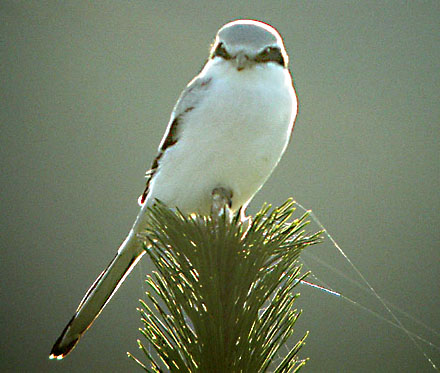
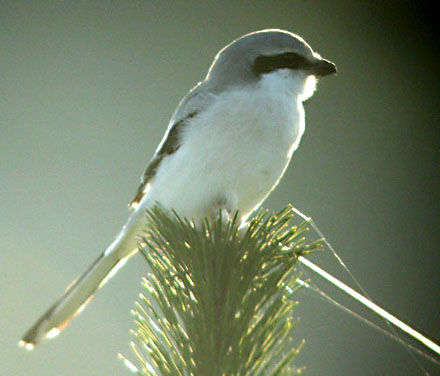
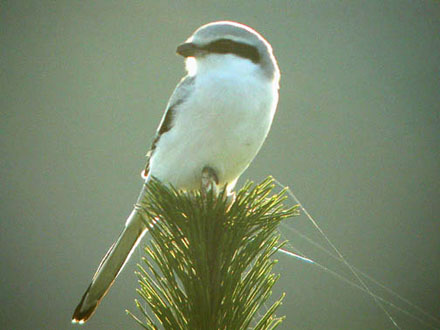
September 22, 2004, © Nial Moores / Birds Korea
On September 20th 2004 a low pressure system took an unusual track and instead of moving east or north-east moved almost due north through the Yellow Sea, carrying heavy rain and moderate to strong westerly winds. This was followed by the passage of an associated weak cold front, resulting in very heavy rainsqualls on Socheong Island in the early hours of the 21st, followed in turn by Beaufort force 3-4 north-westerlies. On the 21st and 22nd skies were clear, and visibility remained very high, while early morning temperatures fell to 13C (the lowest temperatures since May) apparently stimulating significant diurnal movement. The weather conditions produced a series of high counts and unusual records on the island, the most noteworthy being a juvenile/immature Band-bellied Crake Porzana paykullii on the 21st: apparently the first observation of this species in South Korea for over 40 years (e.g. Park, 2002).
On the 22nd, diurnal migration continued reasonably strong and diverse, with raptors, wagtails and hirundines all moving west in significant numbers.
At 5 pm, a scan through a tripod-mounted telescope of an almost inaccessible ridge about 150 to 200 m away (and less than 200 m from another hilltop which had held a Chinese Grey Shrike Lanius sphenocercus on September 14th and 15th) revealed a grey shrike sitting half-obscured in a low-lying thorn bush.
Although the bird appeared large, it was very difficult to gauge size or to see plumage details. Although it seemed most likely at first to be the same or another Chinese Grey Shrike it appeared less obviously longer-tailed than that species. In addition, it seemed distinctly lethargic.
Several distant digi-scope images were taken, and after 40 minutes of wading through the vegetation to get closer, the bird was accidentally flushed from the same spot. Expecting it to fly to the next ridge, the bird instead flew only 10 m to perch on top of the closest pine tree, where it remained for the next 5 minutes, apparently unconcerned by NM’s presence. The tree was the highest point on the ridge, in the center of a narrow strip of tangled grasses and bramble scrub, with rocky outcrops, surrounded by rather extensive secondary growth pine plantations.
A series of close digi-scope images (through a handheld Nikon coolpix) were taken, but always into the sun. As the light was threatening to fade, NM tried to move along the narrow ridge, to get behind the bird to see the upperparts more clearly.
Not surprisingly the bird flew, dropping down off the ridge and out of view. It did not reappear that evening, and could not be found the next morning, despite several hours of searching.
The views in the field, and the resultant images, reveal a large grey, black and white shrike. Its size (combined with its lack of pale edged greater coverts or black forehead) ruled out the possibility of the unrecorded Lesser Grey Shrike Lanius minor, or the even more unlikely possibility of a North American Loggerhead Shrike Lanius ludovicianus, and narrowed the possible species to Chinese Grey, Great Grey Lanius excubitor, Southern Grey Lanius meridionalis, or Steppe Grey Shrike L. (m.) pallidirostris.
The bird appeared rather big-headed, slim-bodied and long-tailed, though again rather shorter-tailed than might be expected in Chinese Grey Shrike. In addition, it showed an oddly “swollen throat” and a long rear crown. The head pattern was well-marked, with a clear white supercilium meeting on the forehead above the bill and a clear black “mask”, with rather less well-marked lores. The throat was clean white, and the rest of the underparts were washed with pale buff (though the exact tones were very difficult to discern due to the angle of the sun and the reflected light coming from the pine tree).
There was no evidence at all of any vermiculations, either on the under- (or poorly seen) upperparts. The underside of the square cut tail appeared grey, with a black subterminal band and a narrow white fringe; the upperside largely black. Most of the upperparts were not seen well. Even on brief or part views from the side, however, it showed very strongly marked white scapulars, white tips to the tertials, with white extending weakly up the tertial edges or perhaps onto the edges of the secondaries. Most of the time the loose flank feathering covered much of the closed wing, though once or twice as the bird shuffled a larger white patch could also be made out, believed to be on the primary bases. The secondaries on the closed wing appeared to lack the extensive white expected of most Chinese Grey, though this feature often appears hard to see on some individuals.
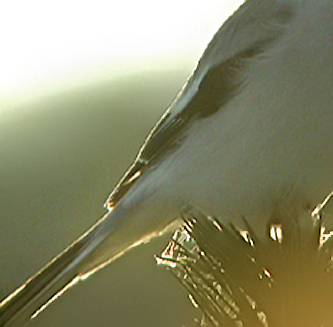
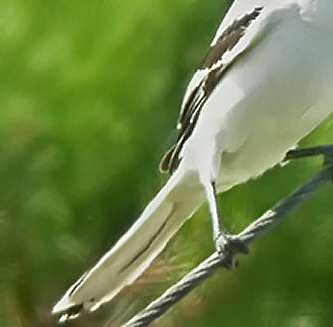
In the two extremely brief flight views (less than 5 seconds in total) it appeared to lack the extensive white wing stripe typical of Chinese Grey Shrike, with white perhaps obvious only on the primaries and not on the secondaries.
When perched most of the upper tail coverts appeared grey (concolorous with the mantle), though the side of the rump occasionally suggested a narrow, poorly defined white or whitish band, something that was also suggested in flight, on the second, better view. This is perhaps discernible in one or two of the images, where at least some whiter feathering is apparent above the tail coverts.
The bill was very deep and short, with a rather paler bill base, with the pale extending up onto the upper mandible. The rictal bristles were weak; stronger-looking than in a Chinese Grey Shrike watched one week previous, but less obvious than in many images of e.g. Great Grey Shrike previously reviewed in Limicola (2001) and on the internet.
The legs were not seen well. In the images the toes at the least appear dark and perhaps slightly brown-toned. Dark brown leg coloration is considered to be a feature of Steppe Grey Shrike by Conzemius (2001).
The Socheong shrike: a long process of identification through elimination.
There is little literature looking in detail at the identification of grey shrikes in Far East Asia, with only Great Grey and Chinese Grey illustrated by Lee, Koo and Park (2000) and Mackinnon and Phillipps (2000), two of the most often used field guides in the region.
Recent taxonomic decisions regarding the “Great Grey Shrike Super-species” which have split the group into Great Grey, Southern Grey and Steppe Grey (e.g. Hernandez et al, 2004), are therefore not covered by regional field guides, and recently developed identification criteria for these newly recognized species remain largely unknown.
Additionally, identification papers written in Europe (e.g. in Limicola in 2001 and Alula in 2002) primarily focus on the separation of Steppe Grey and Southern Grey Shrikes from more western subspecies of Great Grey Shrike (not covering eastern and Nearctic taxa), and do not consider Chinese Grey Shrike at all - a species sharing many Steppe Grey type features.
The possibility of misidentification of grey shrikes in this region therefore remains relatively high.
Discussion on the identity of the Socheong shrike therefore seems to offer an excellent opportunity to refine knowledge and to increase understanding of potentially useful identification criteria, not only of grey shrikes in general, but of Chinese Grey and Steppe Grey Shrike especially. (This seems especially so as the images do not actually reveal many of the key features that, based on present knowledge, would make separation of Chinese Grey and Steppe Grey Shrikes rather straightforward.)
The status of grey shrikes in South Korea
Only two species of grey shrike have so far been recorded in South Korea, Great Grey and Chinese Grey Shrike, and neither are at all numerous.
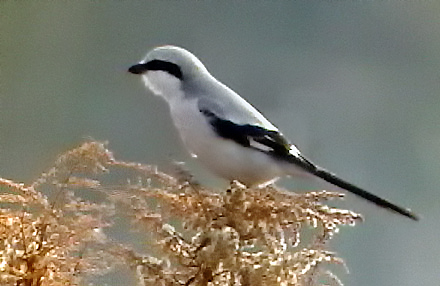
In a review of most published and well-documented records, Park (2002) lists only 5 records of Great Grey Shrike (all falling between November 23rd and February 26th, and all considered to be of the eastern subspecies bianchii), while Chinese Grey is considered a “rare winter visitor” to the country (Lee, Koo & Park, 2000), even though it is easily the most regular of the grey shrikes to occur. Five pairs of nominate Chinese Grey Shrike have for example been found recently breeding in the Cheorwon basin, part of the DMZ (Lee Ki-Seop in lit. 2002), and probably between 10 and 20 or more individuals winter nationwide most years (October-February), typically in rice-fields and wetland edge habitats.
In autumn, the earliest migrant Chinese Grey Shrikes appear to arrive at coastal sites in mid-late September, with at least four records of Chinese Grey Shrike in South Korea in the ten days preceding the Socheong shrike, with one near Gunsan on September 11th, one on Socheong Island on September 14th and 15th, two on Hong Island, and another on neighboring Heuksan Island in the far southwest, also in "mid-September". Neither Southern Grey nor the long-distance migrant Steppe Grey have been recorded in South Korea, though one photograph in the 550 series (Iozawa H., Yamagata N., & T. Yoshino, 2000: plate 2) apparently depicts a first-winter Steppe Grey Shrike in Japan (in December), while another individual "Great Grey Shrike" photographed in southwest Japan in January 2003 (Fig 6) also appears likely to be a Steppe Grey Shrike. In addition, possibly two further individuals photographed in mid-winter in Seosan and Gangneung in South Korea also appear to suggest several characters of the taxon.
As a long-distance migrant breeding as far east as Mongolia, and wintering as far west as North-east Africa, and with a proven record of vagrancy to western Europe, it seems quite possible that Steppe Grey Shrike might occasionally occur in Far East Asia, yet be easily misidentified or overlooked within the region.
Diagnostic Identification features
The Socheong shrike lacked brown tones in the upperparts; lacked vermiculations on the underparts; lacked a clear covert bar or brown-washed feathers in the closed wing. These three features suggest that it was an adult, but of what species? As identification criteria for this group of shrikes are rather complex (especially due to the numbers of different subspecies involved) Southern Grey, Great Grey, Chinese Grey and Steppe Grey Shrike all need to be considered in establishing an identity for the Socheong shrike.
Southern Grey Shrike, comprised of numerous subspecies, would not be expected to occur as a vagrant to Far East Asia, being largely a resident or short-distance migrant. More importantly, each subspecies of Southern Grey shows at least one difference from the Socheong shrike - either the underpart coloration, the rump, the head pattern or the supercilium - and can therefore be safely eliminated from consideration.
The Great Grey Shrike is also comprised of many subspecies. The widespread eastern form of Great Grey Shrike is sibiricus, which according to both Conzemius (2001) and Perttula & Tenovuo (2002) shows rather brown toned upperparts and also in most/all plumages some clear vermiculations on the underparts. The lack of brown tones on the upperparts or vermiculations on the Socheong shrike clearly eliminates sibiricus Great Grey. Several other subspecies of Great Grey also need to be considered: the smaller and paler bianchii (nesting in Sakhalin and the Kurile Islands), nominate excubitor, the Nearctic subspecies, and most especially Central-East Asian homeyeri. Bianchii is said to largely resemble sibiricus, so can be discounted; the Nearctic subspecies apparently all show even stronger vermiculations on the underparts than sibiricus; and homeyeri, though rather similar in some respects to both Steppe and Chinese Grey shows wholly white uppertail coverts.
Most of the visible uppertail coverts were grey in the Socheong bird, which along with less extensive white in the secondaries and possible differences in the tail and head pattern, eliminates homeyeri.Nominate excubitor, an unlikely taxon on range, should show considerably less white in either the closed or the spread wing than the Socheong bird, lacks a white rump band, and according to Svensson (1992) show no white above the bill base.
If this process of elimination outlined above is accurate, then only two choices remain: either Chinese Grey or Steppe Grey Shrike.
Separating Chinese Grey and Steppe Grey Shrikes in the field
Chinese Grey, the only regularly occurring grey shrike in South Korea, and Steppe Grey Shrike appear to share a number of features, many of which are considered useful in western Europe for separating Steppe Grey pallidiriostris from Great Grey (and Southern Grey).
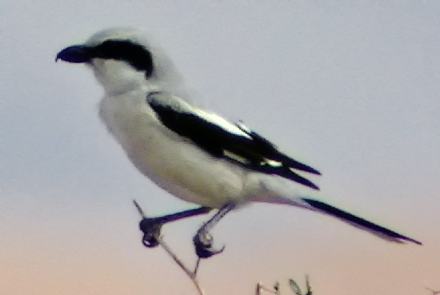
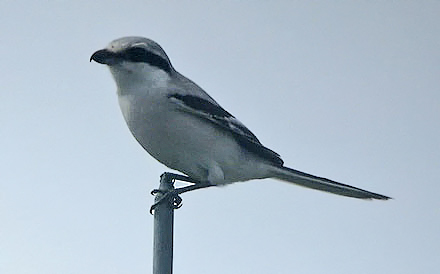
Both are largely pale; both perhaps lack clear vermiculations or brown tones in any plumage (though some literature suggests juvenile Chinese Grey shows some buffy-grey barring on the upperparts); both show extensive white in the closed wing (including broad white tertial tips, with white extending along the edges of the tertials or across on the secondaries); both often show largely pale or at least not solidly black lores; and finally both, it has been suggested, show some graduation in the tail, with the central tail feathers longer than the outer ones. Although this last feature appears easy to discern in all Chinese Grey Shrikes with fresh-looking tails, it does not seem, based on images, to be at all typical of pallidirostris, which look to have rather narrow and square-ended tails.
In direct comparison of the two species, size alone should allow ready identification. Chinese Grey is typically a very large, long-tailed looking shrike. Measurements given in Lee, Koo and Park (2000) suggest that Chinese Grey is 31 cm in length, while Great Grey Shrike is significantly smaller, at 24 cm.
These measurements are repeated in the rather unreliable Mackinnon and Phillipps (2001), which indicates that Southern Grey is similar in measurements to Great Grey. Svensson and Grant (1999) include Steppe Grey Shrike within Great Grey, and give overall length as 22 cm to 26 cm. Chinese Grey Shrike is therefore typically ca 20% larger in total length than Steppe Grey Shrike.
In addition, behaviour might provide some useful clues. Conzemius (2001) states that both Southern Grey Shrikes and Steppe Grey Shrikes observed in Europe often flush only short distances (20 m in some areas) and can be rather approachable. This accords with CM’s experience in the Middle East, where excellent views of grey shrikes can be obtained at eg Dubai Golf Course where they commonly fly from post to post along fences, often perching at close range to an observer. In contrast, NM’s personal experience suggests that Chinese Grey Shrikes are associated with wetland habitats; that they are often rather difficult to approach; and that they typically fly significant distances once flushed (from 50 m up to several hundred meters, often into reedbeds or riverine vegetation if available).
It is very interesting in this regard to note the fearless or unconcerned attitude of the Socheong shrike: flushed at close range, it flew only 10 m to perch on top of the nearest tree.
Estimating the size and structure of the Socheong shrike
It is well-known that judging the size of lone birds can be very difficult, especially when unfamiliar species are involved. Additionally, the length and structure of certain long-tailed species (such as shrikes) can also appear strikingly different due to posture: at times the same individual can appear either short-tailed and compact or long-tailed and elongated. Lacking opportunity to measure the bird in the hand, the decision was therefore made to estimate its total length by comparing it to the branch on which it had been photographed. NM therefore took the reluctant step of climbing the tree the bird had been in, and breaking off the part on which the bird had been sitting. Measuring this part of the branch, and then comparing the width of the branch (8 cm from the long pine needle at upper left to the higher needle on the right,), with the bird in the images, allowed an approximate measurement of the bird to be made: 23 to 24 cm from tail tip to crown above the bill base.
This approximate measurement, open to a significant degree of error, nonetheless closely matches the expected length of Steppe Grey Shrike. Further coarse measurements of images to gauge proportions (e.g. the ratio of tail length to overall length) seemed to suggest that although the tail of the Socheong shrike appears proportionately longer than images of a pallidirostris photographed in Mongolia, it still seems shorter than that shown by some Chinese Grey. In the field, it seemed to lack the “Magpie look” often suggested by Chinese Grey Shrike.
Three further structural differences that strongly suggest Steppe Grey Shrike are also apparent in the Socheong shrike:
Most Chinese Grey Shrike apparently show rather long and reasonably slender bills. The Socheong shrike had a very deep-based bill, with an apparently convex lower mandible (rather suggestive of plate 52, that of a juvenile Steppe Grey Shrike, in Conzemius (2001).
Most Chinese Grey seem to have a rather slender head shape. The Socheong shrike had a very curiously swollen look to its throat, caused apparently by denser and less smooth feathering, and a rather full-looking nape. A similar structure is apparent in images 55 and 56 of adult Steppe Grey Shrikes in Conzemius (2001).
Most importantly, the tail of Chinese Grey Shrike is often obviously graduated, with significantly longer central tail feathers, while Steppe Grey Shrike from images appears to have a rather more square-ended tail often apparently with a slight cleft. The Socheong shrike had a clearly square-ended tail, with the effect of a slight cleft, and no evidence of graduation.
Features of Chinese Grey Shrike
Due to a lack of personal experience of Steppe Grey Shrike, limited experience of Chinese Grey, and obvious contradictions contained in texts on Chinese Grey and Steppe Grey Shrikes available to the author, for NM at least it remains extremely difficult to know which identification criteria are completely reliable.
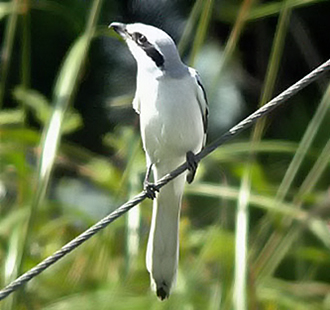
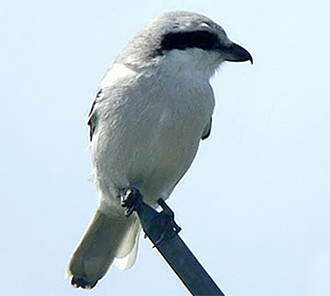
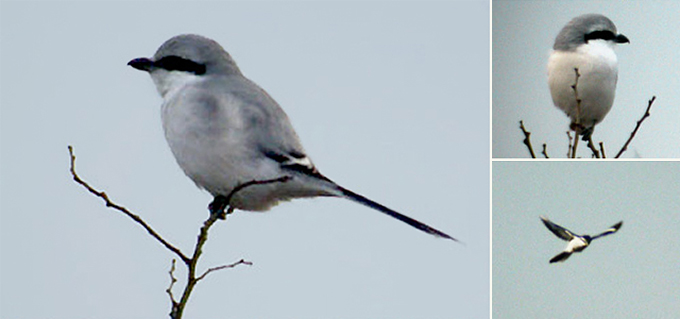
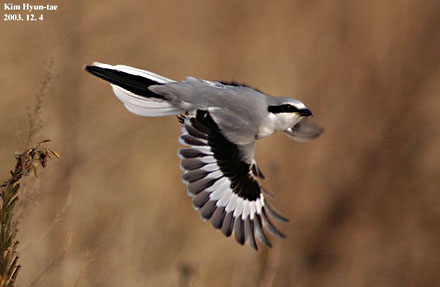
In this stunning flight shot note the poorly marked supercilium, the white forehead spot, the very extensive white on the wing and tail, the lack of extensive white on the scapulars, and also the shape of the tail feathers: very short white outers and very long black central tail feathers, leading to an obviously graduated look.
The Chinese Grey Shrikes seen recently in South Korea by Nial Moores (i.e. 6 individuals in the past 12 months, with perhaps 15 to 20 others seen in Japan and South Korea in previous years) all showed pale underparts when perched, lightly washed with grey, appearing reasonably dark and dull in overcast conditions, contrasting with a white throat. All lacked an obvious, clean white supercilium (though in some depictions of Chinese Grey Shrikes a strong supercilium is apparent), instead showing some white above and behind the eye, some paler grey above the lores, and also a small area of white on the forehead. In all six recently seen individuals, the “mask” was quite extensive, rather narrow and long, with in some, some darker feathers extending down from the lower rear edge. The lores were sometimes rather black, sometimes or more often rather paler. The bills were rather dark (especially adult types perhaps?), with often a paler grey or sometimes even horn-toned base to the lower mandible (the latter especially in first winters?). Often the flank feathers were fluffed up, covering much of the wing. However, all recently seen individuals showed broad white tips to the tertials, white running along the edge of the tertials, and some white apparent also on the secondaries of the closed wing. In many the scapulars were not well-defined, lacking very extensive white. The underside of the tail invariably appeared very largely white, with an obvious black tip showing on the longest central tail feathers.
In flight, Chinese Grey can be easily separated from Steppe Grey Shrike on account of the white wing stripe continuing from the primaries across most of the secondaries (thus recalling homeyeri Great Grey). Additionally in the birds seen recently in South Korea the rump and upper tail coverts appeared typically concolorous with the mantle, and, from above, the tail often appeared largely white with black central tail feathers.
Additionally, follow this link for some excellent images of Chinese Grey Shrikes from China (and note the variation in head pattern, but the typical pattern shown on the underside of the tail): Chinese Bird Gallery.
(With thanks to Bjorn Johansson)
Features of Steppe Grey Shrike
According to available literature, in Steppe Grey Shrike as in Chinese Grey, the extent of the black on the lores appears to vary with age, and perhaps time of year. Based on images and descriptions in a range of literature most show extensive pale admixed into the lores (while one photographed on the breeding grounds in Mongolia, Fig. 7, showed solidly black lores). The “face mask” is fairly extensive, and appears to curl down at the lower rear edge. Interestingly, grey seems to extend from the nape sides to just under the black at the rear of the mask in several of the images in Conzemius (2001), a feature apparent in the Socheong shrike, and not yet noted in Chinese Grey Shrike.
The upperparts are often pale to mid-grey, with rather prominent white scapulars, and a single large white patch on the closed wing, in addition to extensive white tertial tips.
In flight, the white on the remiges appears mostly as a white patch on the primaries. The upper tail coverts are grey, or white but the rump typically appears paler, even white (though some images of pallidirostris seem to suggest that this feature too is somewhat variable). The underparts apparently range from almost white to washed through with grey tinged brown or even rusty brown, contrasting with a white throat. Based on image 49 in Limicola, the underside of the tail appears rather grey, with a clean black tip, very similar to the tail pattern shown by the Socheong shrike.
Review of the features of the Socheong shrike
Coarse estimates of length suggest that the Socheong shrike was approximately 24 cm in total length, matching Steppe Grey Shrike, and some 20% smaller than typical Chinese Grey.
The tail looked long, but not as long as in typical Chinese Grey, and appeared square cut and not graduated or wedge-shaped as in Chinese Grey.
The primary extension beyond the longest tertial is not clear in the image, nor was it noted in the field. It seems unlikely that the extension that is visible would rule out either Chinese Grey or Steppe Grey.
The bill and head shape appeared closer to Steppe Grey than typical Chinese Grey, with a ruffled-looking densely feathered throat, a full rear nape and a very deep, heavy bill.
When perched the bird showed a strong white supercilium that joined on the forehead, typical of Steppe Grey and rather unusual or even exceptional in Chinese Grey.
The very subtle pattern of grey and black at the rear of the ear coverts appears to match Steppe Grey, rather than Chinese Grey (though this could have been simply a product of individual variation or posture?), while the pattern on the lores matched Steppe Grey and some Chinese Grey.
The scapulars appeared very striking, white and extensive. This is said to be typical of Steppe Grey, but is apparently not usual in Chinese Grey.
Most of the underparts appeared to show a faint buffy tone, said to be typical of Steppe Grey and considered very unusual in Chinese Grey. Only one Chinese Grey (Fig 12) out of ca 20 seen by NM so far seemed to show some slight buffy or brown tinge to the grayish underparts.
The underside of the tail appeared grey, with a black subterminal tip, and white terminal fringe. This pattern appears to match images of Steppe Grey, and appears very different from the typical pattern on the underside of the tail of Chinese Grey (white, with a prominent black terminal point).
The upperside of the tail in the images taken seems to show a largely white outer tail feather, becoming however indistinct towards the tail tip (a feature shown by images of Steppe Grey in Conzemius, 2001). These images seem to contradict the sketch (abb 54, p. 223) in the same paper, where the outer tail feather is drawn very thickly and consistently white along its length. In Chinese Grey it appears that possibly at least the two outer pairs of tail feathers are white, so that the white edge to the closed tail is very striking, even from the side.
At rest a suggestion of white at the base of the uppertail coverts or lower rump can be seen in the images. This appeared as a pale or white rump band in flight. This is typical of Steppe Grey and might be considered exceptional in Chinese Grey (some descriptions have suggested that Chinese Grey might also show a white or at least pale rump band).
When perched, the area of wing exposed appears to show extensive white at the tips of the tertials, with white extending up the side of the feathers towards the base, and perhaps extending to the secondaries. This matches the description given in Conzemius (2001) for Steppe Grey, though might be largely shared by Chinese Grey.
The images and observation suggested that the bird lacked the extensive white on the secondaries, which often forms a kind of broad white arrowhead on the exposed closed wing of many Chinese Grey (for example as shown in plate 1, p. 151, of Iozawa H., Yamagata N., & T. Yoshino, 2000). In flight, the bird appeared to lack the diagnostic broad white stripe across the primaries and several of the secondaries shown by Chinese Grey.
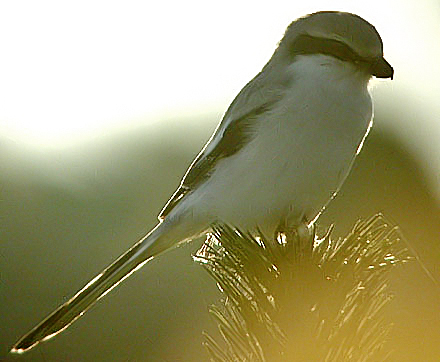
Although badly lit, this image shows a number of features appearing to suggest Steppe rather than Great Grey or Chinese Grey.
Summary
A large grey shrike was seen and digiscoped on Socheong Island, South Korea, on September 22nd, 2004. Based on its general patterning and size, and some plumage details it can be confidently identified as either a Steppe Grey Shrike, or a Chinese Grey Shrike. Furthermore, based on a coarse estimate of its size; on general structure; on the head pattern; pattern on the scapulars; pattern on the remiges; pattern on the underside of the tail; the presence of a narrow white or whitish rump band; and the lack of an obviously graduated tail, it can perhaps be (tentatively) identified as a Steppe Grey Shrike L. (meridionalis) pallidirostris. Although Chinese Grey Shrike is a scarce species in South Korea, Steppe Grey Shrike has yet to be recorded.
Because of the author's lack of experience of the species, and the lack of adequate identification material covering grey shrikes that might occur within the region, this online note has therefore been written with two aims:
to record the observation, and
to elicit informed opinion on its identity.
Please email to idnotes@birdskorea.org.
With many thanks in advance.
Acknowledgements
Birds Korea would like to thank Jochen Roeder for very kindly both providing and translating the Limicola article on grey shrikes (very many thanks); Bjorn Johansson for providing images and information from Alula and other multiple sources, as well as much very valuable discussion; James Lidster for kindly providing images of Steppe Grey Shrike from Mongolia; Kim Hyun-tae for kindly allowing use of his superb images; and Atle Ivar Olsen for kindly providing both images and information on grey shrikes seen in Japan.
References:
- Conzemius, T. (2001) Die Superspezies Raubwurger lanius [excubitor] in der Westpalaarktis. Limicola 15 (2001): 185-227. In German. (very kindly translated into English for Birds Korea by Jochen Roeder)
- Hernández M.A, Campos F, Gutiérrez-Corchero F. & A. Amezcua. Identification of Lanius species and subspecies using tandem repeats in the mitochondrial DNA control region. Ibis, April 2004, vol. 146, iss. 2, pp. 227-230(4) Blackwell Publishing
- Iozawa H,, Yamagata N., & T. Yoshino. (2000). Nihon no Tori 550. Sanya no Tori (“Birds of Japan 550, Land birds”). In Japanese).
- Lee, W-S, Koo, T-H & J-Y Park (2001), A Field Guide to the Birds of Korea. Published by LG Evergreen Foundation.
- Mackinnon, J. & K. Phillipps (2000). A Field Guide to the Birds of China. Oxford University Press.
- Park J-Y (2002). Current Status and Distribution of birds in Korea. Unpublished doctoral thesis, Kyung-Hee University. In Korean
- Perttula & Tenovuo (2002). Great Grey Shrikes Subspecies excubitor, sibiricus and borealis. Alula, 54-60, 2/2002
- Svensson, L. (1992). Identification Guide to European Passerines.
- Svensson L., & P. Grant. (1999). Collins Bird Guide. HarperCollins Publishers.
Taxonomic Note
Studies confirm that there is significant genetic divergence between the more northern Great Grey Shrikes and the more southern nesting subspecies of Southern Grey Shrikes.
In addition, there are consistent differences in plumage, and apparently in behaviour, while there are no proven cases of interbreeding. According to a fairly recent paper in Limicola (Conzemius, 2001), there has also been a recent focus on the identification of pallidirostris, variously considered the eastern subspecies of Southern Grey or as a distinct species in itself. This interest has recently culminated in a paper by Hernández et al (2004), which apparently recognizes pallidirostris as a genetically distinct taxon, comprised of two subspecies (nominate pallidrirostris and aucheri).
Birds Korea is very grateful to Axel Braunlich for mailing us the following links to online photographs of both Steppe Grey and Chinese Grey Shrikes:
pallidirostris:
1 from UAE: www.warbler.phytoconsult.nl/uae/
1 from UAE: www.aves.be/images/leclercq
2 from Oman: www.birdsoman.com/SteppeGreyShrike
3 from Oman: www.magikbirds.com/image.asp?title_class=672
1 from Denmark: www.bornholmsfugle.dk/Billeder/Steppetornskade
1 from Sweden: w1.155.telia.com/~u15506372/stapva2m.jpg
1 from Isle of Man: www.homepages.mcb.net/wormwell
3 from Israel: www.birdingisrael.com/birdNews/recentSightings/2002
Chinese Grey:
from Kyushu:www6.plala.or.jp/yasei/report/Kyu
from Japan homepage2.nifty.com/kawazu/new_page_51.htm
from Japan: www.geocities.co.jp/NatureLand-Sky/4703/021218.htm
from Korea: aves.birdinkorea.net/report/02-11
Comment from Jochen Roeder (Sept 29)
"I am very far from being anything like an expert on the matter, having only seen Steppe Grey once or twice...What I found very interesting was to compare your bird with the one from Japan (figure 6). The general impression (shape, facial expression) and the plumage details visible are all in accordance, so I would say both very probably belong to the same taxon which is already a very interesting result...
When looking at the separation of Steppe and Chinese Grey Shrikes, a major problem became very apparent: the general lack of knowledge/publications on the plumage variation of Chinese Grey Shrike! The whole text is characterized by words like "Chinese apparently shows...", "...seems to have...", "...is said to be typical...", "...is apparently not typical...", "...rather unusual or even exceptional...", "...it appears that possibly..." and so on. Therefore one gets the impression that with the current knowledge on the colouration or patterning of the species, plumage features don’t offer a definite argument for or against one species or the other. With the wing pattern (as a straight forward field character for separating the two) not being visible on the photos of the Socheong bird, it consequently seems to be very difficult, if not impossible, to identify the shrike on colouration or patterning alone, though I agree with you that the field characters are all better matched with Steppe than with Chinese...
I was absolutely stunned by the flight shot of the Chinese ([KIM Hyun-tae’s amazing flight shot] figure 14). Not only is this an exceptionally beautiful picture of a flying bird but I was also fascinated by the strongly graduated tail of the species, with the outermost tail feather being (roughly) only half the length of the longest central feather. So my attention was immediately focussed on this unusual feature and I checked the other photos of Chinese Grey Shrikes to see how one could detect this graduation on the folded tail of perched birds. It is a bit difficult as one has to make out borders of white feathers against a white background, but it is possible. The undertail of Chinese Grey Shrike clearly shows three "steps" or "lines" of feather tips: the first one is created by the outermost tail feathers which end roughly half way between the tail tip and the base of the tail. The second outermost tail feathers form the second step which is roughly half way in between the first step and the tip. The rest of the tail feathers form the last step, ending only shortly before the longest, black central tail feathers. I have looked at the images in Conzemius (2001) and none of the shrikes there showed such short outer tail feathers (aucheri got quite close though, see Abb. 45 and 46), so this seems to be a good field character of Chinese (again, you see the word "seems")...
Now looking at the Socheong bird, the spacing of the tail feathers can be seen very clearly and the shortest, outermost tail feather ends very close to the tip of the tail, differing very strongly from the pattern shown by Chinese. This could of course be attributed to moult, but as the pictures of the Chinese Grey Shrike (showing the short outer tail feathers) were taken only a few days before the Socheong bird, this should be unlikely. I furthermore do not think that feather length can vary to such a great extent and therefore the lack of a very short outer tail feather could be regarded as a strong argument (maybe stronger than colouration) to rule out Chinese Grey Shrike when trying to determine the identity of the Socheong bird!
So, it all points clearly towards the bird being not a Chinese Grey Shrike...
...Chinese Grey can be excluded, so the only taxon that’s left is indeed Steppe Grey. But regarding this, there’s also a few critical or indeed interesting aspects: when taking into account that all plumage features discernible on the Socheong bird (like supercilium, colouration of the breast, lack of a white spot on the forehead, tail colouration and structure) apparently differ from (typical?) Chinese Grey Shrike, I would say the arguments for excluding this species are basically as strong as the ones for excluding other forms of grey shrikes (Great Grey, immature Lesser Grey etc.) with the sole exception of Steppe!
But regarding Steppe Grey, the literature that is accessable to me (your note and Conzemius’ article) also leads to a few questions of importance when identifying the Socheong bird.
Looking at the photos of adult Steppe Shrikes in Conzemius (2001), there are a few significant differences to the Socheong bird, especially regarding the black mask:
The lores of all three adult Steppe Shrikes in Conzemius are almost entirely grey, indeed of almost the same colour as the upper head and back.
The lores of the Socheong bird are clearly as black as the mask behind the eye, although not extensively so (narrowing strongly towards the bill).
Another interesting aspect visible on all of the photos of adult (and immature) Steppe Shrikes in Conzemius: the black mask behind the eye does not reach the eye itself because this is surrounded by a thin ring of paler greyish feathers. The black eye therefore stands out clearly against the black mask. In the Socheong bird, the black eye is barely visible, being entirely surrounded by the black mask and lores. This results in a strikingly different, more open facial expression of the Steppe Shrikes in Conzemius compared to the Socheong bird.
The shrikes in Conzemius were photographed in Oman and the Arab Emirates, so one can assume they originate from the western part of the taxon’s breeding range. But when turning to the images of Steppe shrikes in your note (fig. 7) (from the eastern breeding grounds in Mongolia and the presumed Steppe of fig. 6 from Japan, probably also originating from eastern breeding grounds), the lores in both birds are black and the eye is obscured by an entirely black mask! This is in perfect accordance with the Socheong bird...
Very interesting! So apparently, Steppe Grey might be a variable taxon with western populations looking (significantly?) different from eastern birds. If this can be confirmed, then one can barely find any substantial arguments against identifying the Socheong bird as an "Eastern Steppe Grey".
But then the relationships of this eastern taxon to other forms of Grey shrikes in Eastern and Central Asia should probably first be established..."



